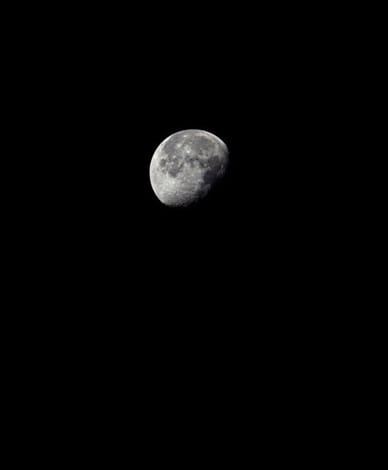Trevor Paglen (b. 1974)
Dead Military Navigation Satellite (COSMOS 985) Near the Disk of the Moon, 2012
Chromogenic print
44 x 36 in.
Gift of John Andrew MacMahon, Class of 1995
It is daringly familiar. At first glance, we recognize the moon: the glistening white against the saturated black. An endeared neighbor to the Earth, for centuries we have been familiar with the moon’s distinctive features—the mottled, dark-gray craters and the lighter shades that bubble across its surface. But still, our pale satellite never ceases to charm us. We share an intimate history with our moon, one which reflects one of the core spirits of humanity; the moon will forever be a symbol of human curiosity.
What distinguishes Paglen’s work from other resourceful images of the moon are the historical and technological aspects of his process. This piece has been made possible by utilizing COSMOS 985, part of a 6-satellite Soviet military navigation system launched in January 17th, 1978—hence the name, Dead Military Navigation Satellite. The satellite computes radio waves with the other satellites and can pinpoint a user’s location to 100 meters within 2 hours. Thus, the use of COSMOS 985 in this artwork summons the reality of surveillance, state, and power: the dark, unavoidable truth behind advancements in technology and research methods, enabling us expand our curiosities in order to know more – to see more.
Trevor Paglen’s works are research-based and investigative, re-interpreting historical moments and “developing the means to imagine alternative futures.” His recent endeavor to launch the communications satellite EchoStar XVI in 2012, a project the artist named The Last Pictures, took years to complete and involved a number of MIT scientists. The satellite is designed to last billions of years. It carries one hundred photographs chosen by Paglen that capture the contemporary time. The only limitation to the project is the Earth’s existence.
Paglen holds a B.A. from U.C. Berkeley, an MFA from the Art Institute of Chicago, and a Ph.D. in Geography from U.C. Berkeley. He has had one-person exhibitions at Vienna Secession, Eli & Edythe Broad Museum (…), and he has participated in group exhibitions in Metropolitan Museum of Art, San Francisco Museum of Modern Art, Tate Modern, and many others. Author of numerous books and articles on experimental geography, state secrecy, as well as military symbology, Paglen is an artist working across image-making, sculpture, and engineering. In 2014, he received the Electronic Frontier Foundation’s Pioneer Award as a “groundbreaking investigative artist.”
Adrienne Lee ’21

